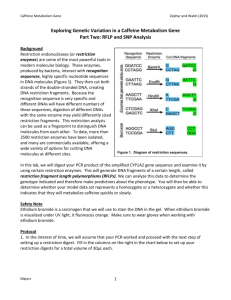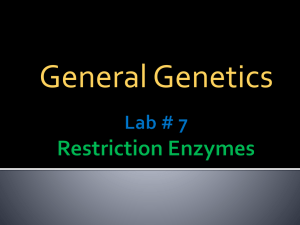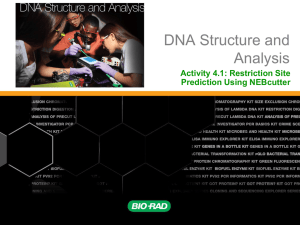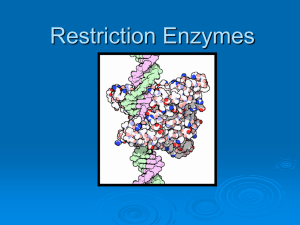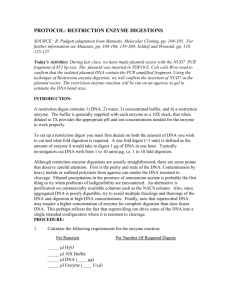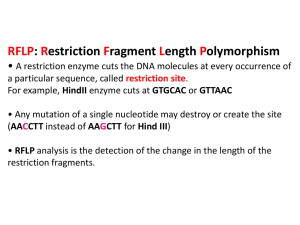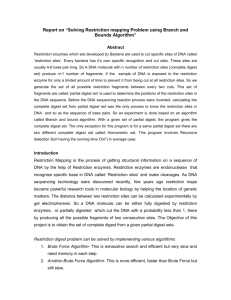Word
advertisement
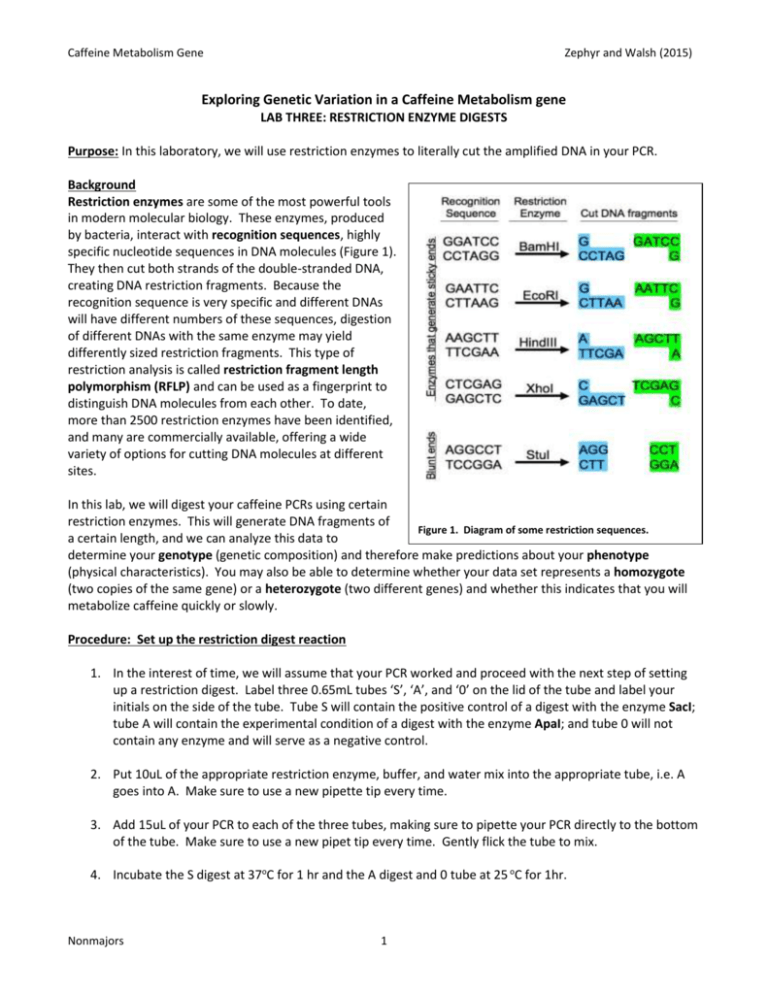
Caffeine Metabolism Gene Zephyr and Walsh (2015) Exploring Genetic Variation in a Caffeine Metabolism gene LAB THREE: RESTRICTION ENZYME DIGESTS Purpose: In this laboratory, we will use restriction enzymes to literally cut the amplified DNA in your PCR. Background Restriction enzymes are some of the most powerful tools in modern molecular biology. These enzymes, produced by bacteria, interact with recognition sequences, highly specific nucleotide sequences in DNA molecules (Figure 1). They then cut both strands of the double-stranded DNA, creating DNA restriction fragments. Because the recognition sequence is very specific and different DNAs will have different numbers of these sequences, digestion of different DNAs with the same enzyme may yield differently sized restriction fragments. This type of restriction analysis is called restriction fragment length polymorphism (RFLP) and can be used as a fingerprint to distinguish DNA molecules from each other. To date, more than 2500 restriction enzymes have been identified, and many are commercially available, offering a wide variety of options for cutting DNA molecules at different sites. In this lab, we will digest your caffeine PCRs using certain restriction enzymes. This will generate DNA fragments of Figure 1. Diagram of some restriction sequences. a certain length, and we can analyze this data to determine your genotype (genetic composition) and therefore make predictions about your phenotype (physical characteristics). You may also be able to determine whether your data set represents a homozygote (two copies of the same gene) or a heterozygote (two different genes) and whether this indicates that you will metabolize caffeine quickly or slowly. Procedure: Set up the restriction digest reaction 1. In the interest of time, we will assume that your PCR worked and proceed with the next step of setting up a restriction digest. Label three 0.65mL tubes ‘S’, ‘A’, and ‘0’ on the lid of the tube and label your initials on the side of the tube. Tube S will contain the positive control of a digest with the enzyme SacI; tube A will contain the experimental condition of a digest with the enzyme ApaI; and tube 0 will not contain any enzyme and will serve as a negative control. 2. Put 10uL of the appropriate restriction enzyme, buffer, and water mix into the appropriate tube, i.e. A goes into A. Make sure to use a new pipette tip every time. 3. Add 15uL of your PCR to each of the three tubes, making sure to pipette your PCR directly to the bottom of the tube. Make sure to use a new pipet tip every time. Gently flick the tube to mix. 4. Incubate the S digest at 37oC for 1 hr and the A digest and 0 tube at 25 oC for 1hr. Nonmajors 1 Caffeine Metabolism Gene Zephyr and Walsh (2015) 5. These reactions will be stored in the freezer until tomorrow’s laboratory. Concept Check and Challenge Question Below is the CYP1A2 DNA sequence. The numbers of the bases are indicated at the right, but the sequence should be read from the first G, as base number 1, to the last G, as base number 743. Recall that there are two CYP1A2 alleles (variations of a single gene) that differ in sequence as the result of a Single Nucleotide Polymorphism (SNP). The underlined and bolded base at position 494 indicates the SNP in this allele. http://www.ncbi.nlm.nih.gov/SNP/snp_ref.cgi?rs=rs762551 Allele 1 GGA GAGCGATGGG GAGGGCTTCC CCCTTAGCAC AAGGGCAGCC CTGGCCCTGG CTGAAGCCCA ACCCCAACCT CCAAGACTGT GAGAGGATGG GGACTCATCC CTGGAGGAGG TGCCCCTCCT GGTATTGATA AAGAATGCCC TGGGGAGGGG GCATCACAGG CTATTTGAAC CAGCCCTGGG ACCTTGGCCA CCTCAGTGTC ACTGGGTAGG GGGAACTCCT GGTCCCTTGG GTATATGGAA GGTATCAGCA GAAAGCCAGC ACTGGCAGGG ACTCTTTGGT ACAATACCCA GCATGCATGC TGTGCCAGGG GCTGACAAGG GTGCTGTCCT TGGCTTCCCC ATTTTGGAGT GGTCACTTGC CTCTACTCCA GCCCCAGAAG TGGAAACTGA GATGATGTGT GGAGGAGAGA GCCAGCGTTC ATGTTGGGAA TCTTGAGGCT CCTTTCCAGC TCTCAGATTC TGTGATGCTC AAAGGGTGAG CTCTGTGGGC A CAGGACGCAT GGTAGATGGA GCTTAGTCTT TCTGGTATCC AGCTGGGAGC CAAGCACAGA ACACGCATCA GTGTTTATCA AATGACTGAG GAAATGAATG AATGAATGTC TCCATCTCAA CCCTCAGCCT GGTCCCTCCT TTTTTCCCTG CAGTTGGTAC AGATGGCATT GTCCCAGTCT GTTCCCTTCT CGGCCACAGA GCTTCTCCTG GCCTCTGCCA TCTTCTGCCT GGTATTCTGG GTGCTCAAG 53 113 173 233 293 353 413 473 494 554 614 674 734 743 The SNP site is variable, of course, and the alternate allele of CYP1A2 has a C nucleotide in place of an A. This alternate allele sequence is shown below. Allele 2 GGA GAGCGATGGG GAGGGCTTCC CCCTTAGCAC AAGGGCAGCC CTGGCCCTGG CTGAAGCCCA ACCCCAACCT CCAAGACTGT GAGAGGATGG GGACTCATCC CTGGAGGAGG TGCCCCTCCT GGTATTGATA AAGAATGCCC TGGGGAGGGG GCATCACAGG CTATTTGAAC CAGCCCTGGG ACCTTGGCCA CCTCAGTGTC ACTGGGTAGG GGGAACTCCT GGTCCCTTGG GTATATGGAA GGTATCAGCA GAAAGCCAGC ACTGGCAGGG ACTCTTTGGT ACAATACCCA GCATGCATGC TGTGCCAGGG GCTGACAAGG GTGCTGTCCT TGGCTTCCCC ATTTTGGAGT GGTCACTTGC CTCTACTCCA GCCCCAGAAG TGGAAACTGA GATGATGTGT GGAGGAGAGA GCCAGCGTTC ATGTTGGGAA TCTTGAGGCT CCTTTCCAGC TCTCAGATTC TGTGATGCTC AAAGGGTGAG CTCTGTGGGC C CAGGACGCAT GGTAGATGGA GCTTAGTCTT TCTGGTATCC AGCTGGGAGC CAAGCACAGA ACACGCATCA GTGTTTATCA AATGACTGAG GAAATGAATG AATGAATGTC TCCATCTCAA CCCTCAGCCT GGTCCCTCCT TTTTTCCCTG CAGTTGGTAC AGATGGCATT GTCCCAGTCT GTTCCCTTCT CGGCCACAGA GCTTCTCCTG GCCTCTGCCA TCTTCTGCCT GGTATTCTGG GTGCTCAAG Nonmajors 2 53 113 173 233 293 353 413 473 494 554 614 674 734 743 Caffeine Metabolism Gene Zephyr and Walsh (2015) 1. The restriction enzyme SacI has the recognition sequence GAGCTC. Find this site in both allele sequences above and highlight both. (Hint: this is not far from the SNP.) 2. SacI cuts between the T and the last C of the recognition sequence. A. If SacI cuts at this site, how many pieces of DNA do you get for each allele? ________________ B. How big is each piece? __________________ bp & __________________ bp 3. The restriction enzyme ApaI cuts at the sequence GGGCCC. Look for this sequence at the SNP site in Allele 2 and highlight it with a different color. Notice that this site does NOT occur in Allele 1 due to the SNP variation. A. If ApaI only is used to digest allele 2, how many pieces of DNA do you get? _______________ B. ApaI cuts between the penultimate and final C of its restriction site. How big will each piece be? __________________ bp & __________________ bp 4. Define the terms positive and negative control. Which samples serve as a positive and negative control in this experiment? Why is each important, and what do you expect to determine from these samples? Nonmajors 3
